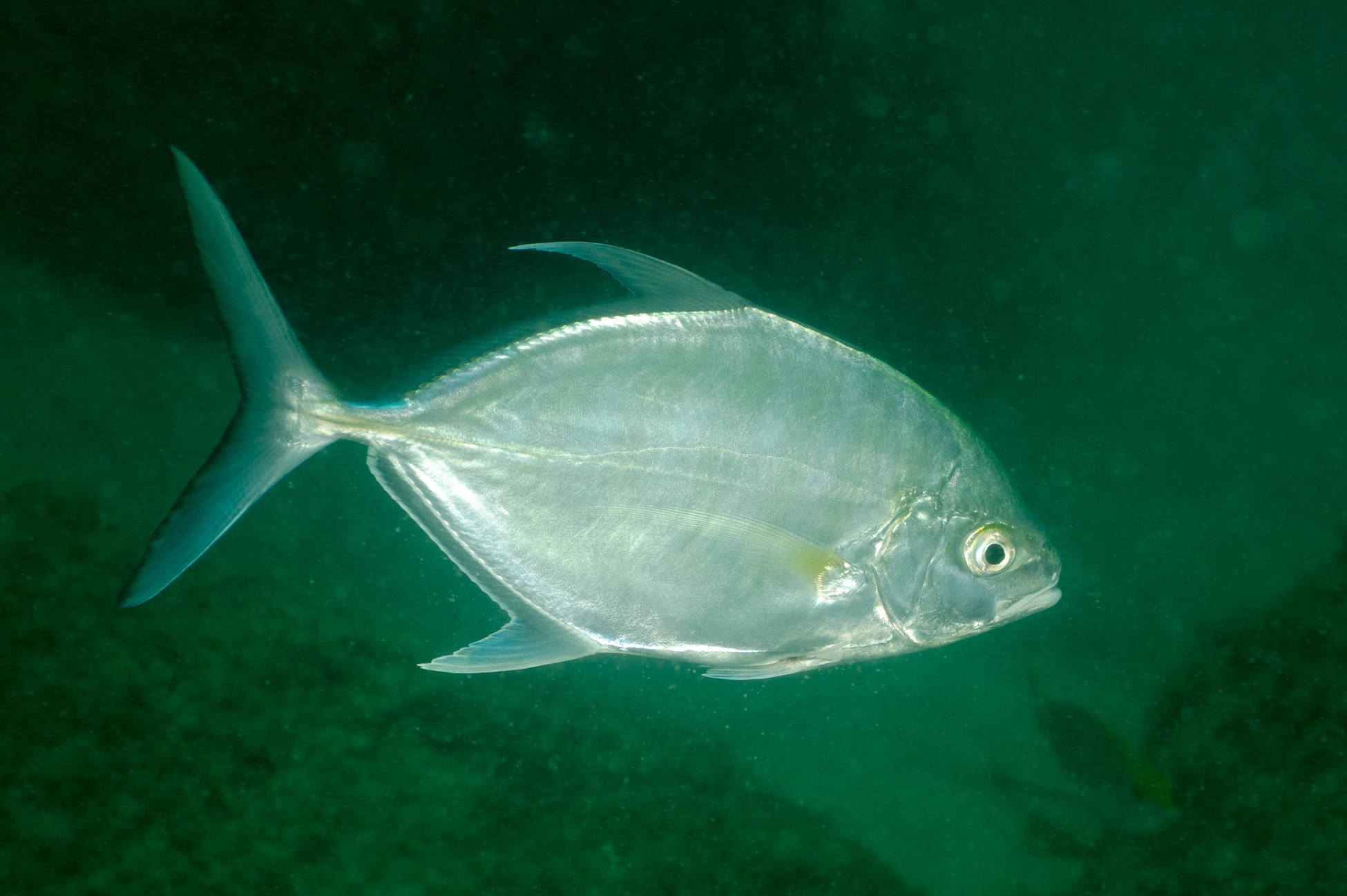- Classification
- ACTINOPTERYGII
- PERCIFORMES
- CARANGIDAE
- Carangoides
- chrysophrys
Longnose Trevally, Carangoides chrysophrys (Cuvier 1833)
Other Names: Club-nosed Trevally, Dusky Trevally, Grunting Trevally, Long-nose Trevally, Long-nosed Trevally, Tea-leaf Trevally

A Longnose Trevally, Carangoides chrysophrys, on the Gold Coast Seaway, southern Queensland, September 2013. Source: Ian Shaw / iNaturalist.org. License: CC By Attribution-NonCommercial
Summary:
A silvery to bluish-green trevally becoming silver with yellowish-green reflections below, with a black spot on the upper margin of the gill cover, long pectoral fins that extend to the straight part of the lateral line, and a blunt snout.
Cite this page as:
Bray, D.J. 2018, Carangoides chrysophrys in Fishes of Australia, accessed 10 Jul 2025, https://fishesofaustralia.net.au/Home/species/4258
Longnose Trevally, Carangoides chrysophrys (Cuvier 1833)
More Info
|
Distribution |
Exmouth Gulf, Western Australia, around the tropical north to Bermagui, New South Wales. Elsewhere the species occurs in the tropical, Indo-west Pacific. Adults are pelagic on deeper coastal reefs, while juveniles usually inhabit inshore areas, including estuaries. |
|
Features |
Dorsal fin VIII, + I, 18-20; Anal fin III, 14-17; Gill rakers (first arch) 5-9, (second arch 15-18); Scutes 20-37 (weak); Vertebrae 24. Pectoral fins falcate; breast scaleless to behind pelvic origin and laterally to pectoral base; soft dorsal-fin lobe falcate in juveniles with anterior rays extended into filaments, lobe becoming shorter than head in adults; first 2 anal-fin spines detached. |
|
Feeding |
Carnivore - feeds on crustaceans and small fishes. |
|
Fisheries |
Taken as bycatch in commercial fisheries. |
|
Similar Species |
Differs from other similar species in having the following combination of characters: scalation of the breast area (naked area of breast does not extend above the pectoral fin), number of gill rakers (21-24) and fin-ray counts (dorsal 19-20, anal 15-16). |
|
Etymology |
The specific name chrysophrys is from Greek and means golden eyebrow. |
|
Species Citation |
Caranx chrysophrys Cuvier in Cuvier & Valenciennes 1833, Histoire Naturelle des Poissons 9: 77, pl. 247. Type locality: Seychelles. |
|
Author |
Bray, D.J. 2018 |
|
Resources |
Longnose Trevally, Carangoides chrysophrys (Cuvier 1833)
References
Allen, G.R. 1997. Marine Fishes of Tropical Australia and South-east Asia. Perth : Western Australian Museum 292 pp. 106 pls.
Allen, G.R. & Swainston, R. 1988. The Marine Fishes of North-Western Australia. A field guide for anglers and divers. Perth, WA : Western Australian Museum vi 201 pp., 70 pls.
Al-Rasady, I., Govender, A. & Al-Jufaili, S.M. 2012. Reproductive biology of longnose trevally (Carangoides chrysophrys) in the Arabian Sea, Oman. Environmental Biology of Fishes 93(2): 177-184.
Brewer, D.T., Blaber, S.J.M. & Salini, J.P. 1991. Predation on penaeid prawns by fishes in Albatross Bay, Gulf of Carpentaria. Marine Biology 109(2): 231–240.
Cuvier, G.L. in Cuvier, G.L. & Valenciennes, A. 1833. Histoire Naturelle des Poissons. Paris : Levrault Vol. 9 512 pp. pls 246-279.
Grant, E.M. 1975. Guide to Fishes. Brisbane : Queensland Government, Co-ordinator General’s Department 640 pp.
Grant, E.M. 2002. Guide to Fishes. Redcliffe : EM Grant Pty Ltd 880 pp.
Gunn, J.S. 1990. A revision of selected genera of the family Carangidae (Pisces) from Australian waters. Records of the Australian Museum, Supplement 12: 1-77
Johnson, J.W. 1999. Annotated checklist of the fishes of Moreton Bay, Queensland, Australia. Memoirs of the Queensland Museum 43(2): 709-762.
Johnson, J.W. 2010. Fishes of the Moreton Bay Marine Park and adjacent continental shelf waters, Queensland, Australia. pp. 299-353 in Davie, P.J.F. & Phillips, J.A. Proceedings of the Thirteenth International Marine Biological Workshop, The Marine Fauna and Flora of Moreton Bay. Memoirs of the Queensland Museum 54(3)
Kuiter, R.H. 1993. Coastal Fishes of South-eastern Australia. Bathurst : Crawford House Press 437 pp.
Kuiter, R.H. & Tonozuka, T. 2001. Indonesian Reef Fishes. Part 1. Eels- Snappers, Muraenidae - Lutjanidae. Australia : Zoonetics pp. 1-302.
Larson, H.K., Williams, R.S. & Hammer, M.P. 2013. An annotated checklist of the fishes of the Northern Territory, Australia. Zootaxa 3696(1): 1-293
Lin, P.-L., Shao, K.-T. 1999. A review of the carangid fishes (Family Carangidae) from Taiwan with descriptions of four new records. Zoological Studies 38 (1): 33–68.
Ramm, D.C., Pender, P.J., R.S. Willing, R.S. & Buckworth, R.C. 1990. Large-scale spatial patterns of abundance within the assemblage of fish caught by prawn trawlers in Northern Australian waters. Australian Journal of Marine and Freshwater Research 41(1): 79-95.
Randall, J.E., Allen, G.R. & Steene, R. 1990. Fishes of the Great Barrier Reef and Coral Sea. Bathurst : Crawford House Press 507 pp. figs.
Randall, J.E., Allen, G.R. & Steene, R. 1997. Fishes of the Great Barrier Reef and Coral Sea. Bathurst : Crawford House Press 557 pp. figs.
Russell, B.C. & Houston, W. 1989. Offshore fishes of the Arafura Sea. The Beagle, Records of the Museums and Art Galleries of the Northern Territory 6(1): 69-84
Sainsbury, K.J., Kailola, P.J. & Leyland, G.G. 1984. Continental Shelf Fishes of Northern and North-Western Australia. Canberra : Fisheries Information Service 375 pp. figs & pls.
Smith-Vaniz, W.F. & Williams, I. 2016. Carangoides chrysophrys (errata version published in 2017). The IUCN Red List of Threatened Species 2016: e.T20257324A115371478. http://dx.doi.org/10.2305/IUCN.UK.2016-3.RLTS.T20257324A46664049.en. Downloaded on 09 July 2018.
Smith-Vaniz, W.F. 1999. Family Carangidae. pp. 2659-2756 in Carpenter, K.E. & Niem, T.H. (eds). FAO Species Identification Guide for Fisheries Purposes. Rome : FAO Vol. 4 pp. 2069-2790.









